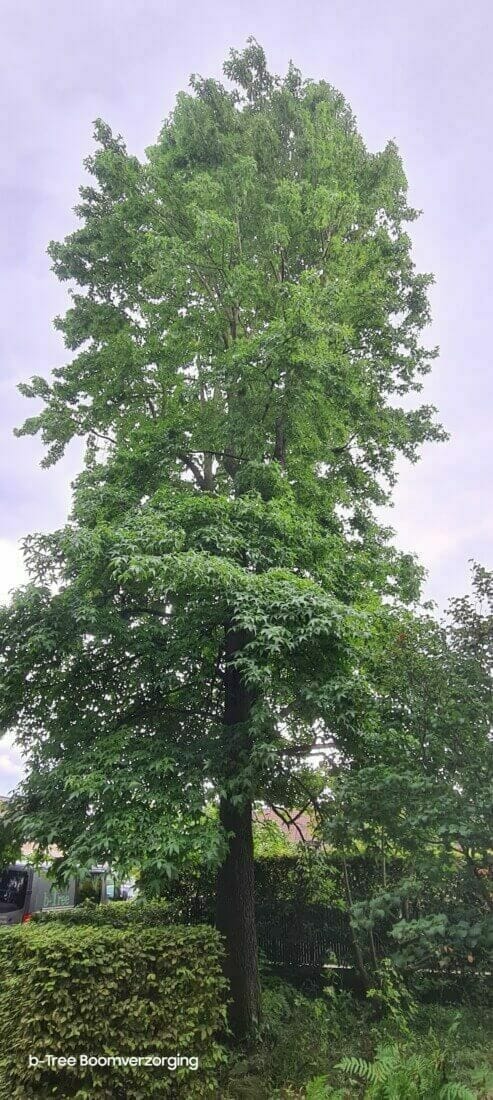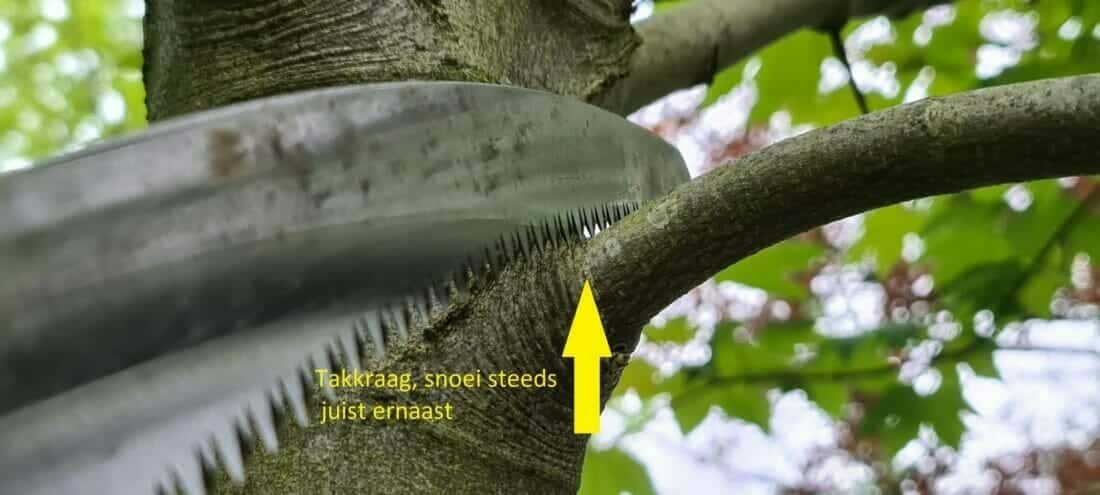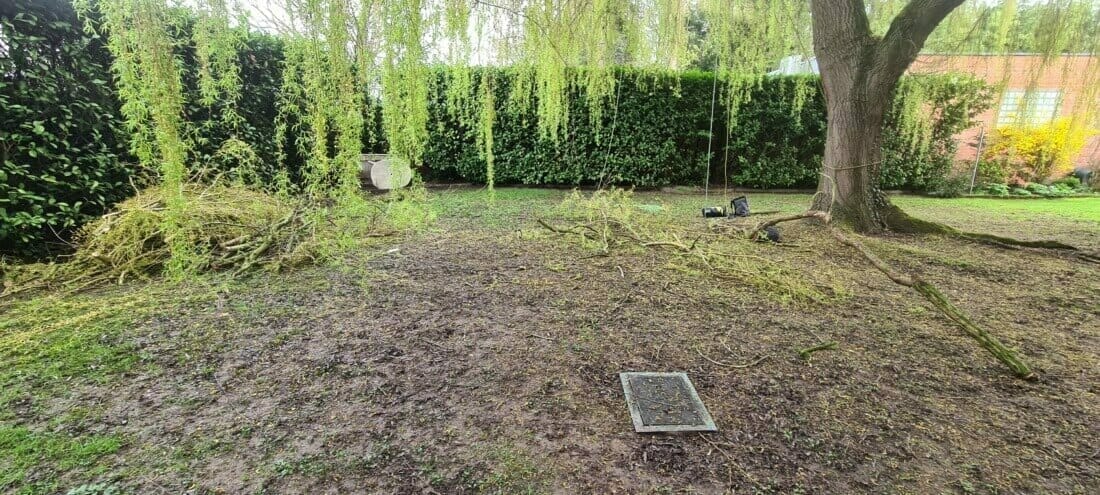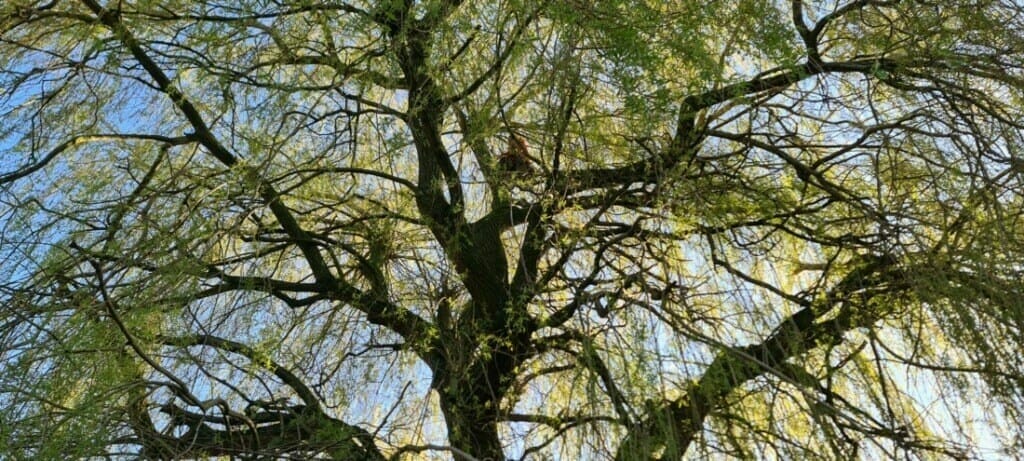

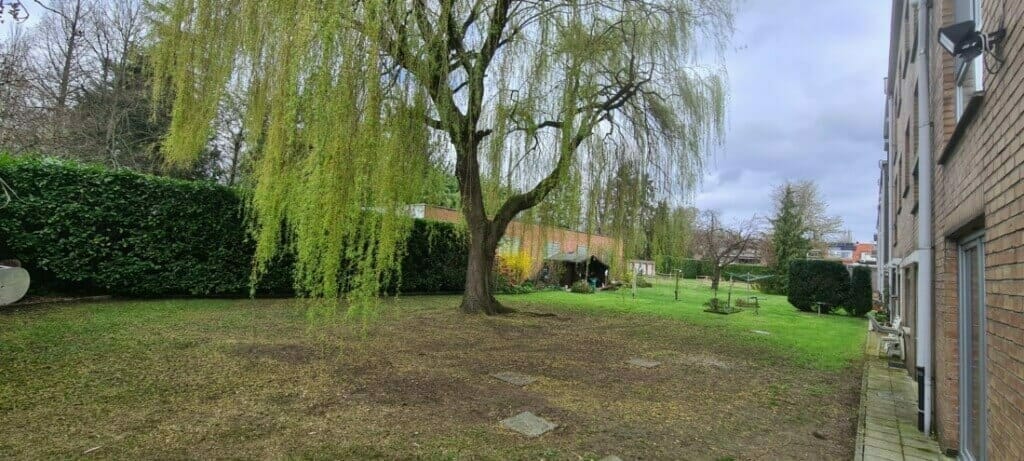
Trimming trees
Alles wat je moet weten over het snoeien van bomen
Bomen snoeien op de correcte manier is een uitdagende taak. Zeker als je ze lang wenst te behouden op termijn. Want een boom snoeien maakt verwondingen en daardoor kan de boom infecties of aantastigen oplopen als je niet correct snoeit.
Daarom leggen we je alles uit over waarom je een boom moet snoeien, hoe je dit best doet, wanneer je dit best doet en de redenen waarom.
We also give you more information about how trees can or cannot seal pruning wounds and the consequences thereof.
En je krijgt informatie over het geschikte snoeigereedschap en de Europese snoeistandaard.
This is completely in line with us ethical policy in the field of trees.
And be sure to read the article about it advice about your trees in a legal dispute. Want vooraleer je bijvoorbeeld overhangende takken van buurmans boom gaat snoeien, ben je best goed geïnformeerd.
Graag wensen we een groot misverstand uit de wereld te helpen: It is better to prune trees in the summer and not in the winter unless you're going to pollard trees.
Why prune a tree?
Een boom snoeien is vaak nodig voor de gezondheid, veiligheid of habitus (vorm) van de boom.
Ook is het vaak nodig voor de omgeving of standplaats van de boom. Als takken bijvoorbeeld te ver overhangen. Of tot tegen een woning of dak aanschuren.
You will also prune trees to give other trees more light. For example, to provide more light to a monumental tree, veteran tree or future tree that is suffering from a lack of light. So that you can keep these valuable trees for longer.
You prune trees for a specific purpose. Below we give several reasons why you should prune a tree:
As a preparation for construction works or a transplantation
When you are going to build or carry out civil works near trees, you need a tree protection plan with measures. One of the measures is often pruning the above-ground parts. This creates more space to work.
But also often to maintain the balance between the crown and the root system. If roots disappear underground, you should also prune above ground. Because with a smaller root package the tree can only maintain a smaller crown and supply it with moisture.
The same applies to it transplanting a tree. Because you will also be pruning roots here, you will also prune the tree above ground.
For the safety
With safety pruning you remove dead branches or diseased branches, which may die in the near future. This prevents the branches from causing damage by falling down.
Around the improve the crown structure of the tree
Branches that can tear because they are too vigorous and become too heavy endanger the tree itself and must be pruned. If a branch that is too heavy tears out, a large tear wound is created in the trunk. This wound provides a gateway for infections.
Because of aesthetic value and form
When the habit of a tree begins to deviate significantly from its natural shape, you can correct the crown. You will also prune the tree regularly with topiary.
Om to give other trees more light
This way, for example, you can better manage monumental trees, veteran trees or future trees photosynthesis have it done. And they have to invest less in letting their branches grow long and expansive on the outside of the crown. To touch light in this way.
These long and often top-heavy branches pose a risk of tearing. And precisely by giving these trees more light, they will invest in the inside of their crown and produce more branches and twigs there. This reduces the risk of developing top-heavy branches and tearing them out.
Preventing nuisance to neighbors
If branches that are too long or thick start to hang over the property boundary with the neighbors, it is better to prune in time.
Before you receive complaints from the neighbors whether the branches are too thick. If you wait too long before pruning, the pruning wounds will be larger and this will be worse for the health of the tree.
The chance of a legal dispute also decreases. Because notice, the legislation prescribes that you must prune overhanging branches.
Read more about possible intervention by our certified tree manager as a tree technical advisor in legal matters.
Around the to ensure tree stability
When a tree's crown is very one-sidedly developed due to a lack of light on one side, the tree can become unstable. By pruning branches along the side that is most mechanically loaded, the risk of windthrow is reduced.
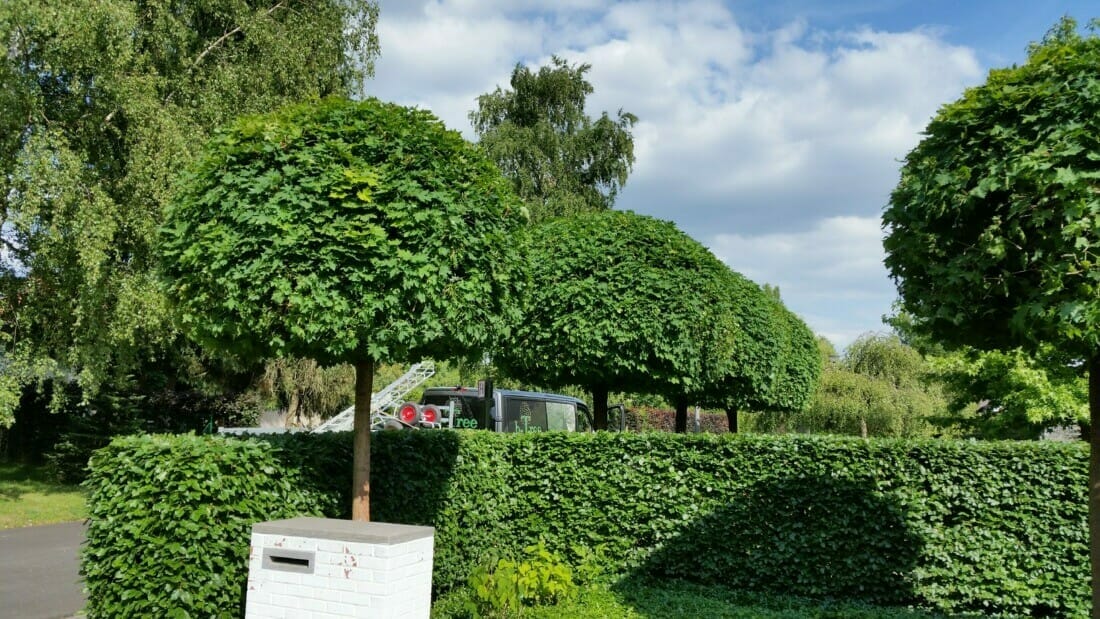
Pruning trees for no reason or pruning too much
Can damage the health and growth of the tree. If it is not necessary to prune, then it is better not to prune. Because pruning always causes injuries and requires a lot of energy from the tree to heal them.
Heb je vragen, twijfel dan niet om ons Contact Form in te vullen. We beantwoorden ze met plezier.
Why prune trees the right way?
Proper and correct pruning will improve the tree structure or crown structure, allow more sunlight to pass through, reduce the chance of branch breakage and increase the aesthetic value of the tree. There will also be a chance attacks be smaller if you prune correctly.
Incorrect pruning, on the other hand, causes damage to trees. It increases the risk of diseases, infestations and pests. It can even lead to serious safety risks. Especially in the longer term, if, for example, major rotting occurs in the frame branches or the trunk. You wish to prevent this at all times.
That is why it is important to follow the best pruning practices, namely those of the European pruning standard. Because this minimizes the side effects of pruning.
ETPS
The European Tree Pruning Standard (ETPS) is a set of guidelines and techniques developed by experts in the tree care. This is so that trees can be pruned correctly and successfully.
This pruning standard for trees, developed by the International Society of Arboriculture (ISA), bevat een reeks praktisch bruikbare principes. Die de gezondheid, veiligheid en esthetiek van de bomen bevorderen.
The standard emphasizes the importance of understanding biology, morphology and physiology of trees, using proper pruning techniques and minimizing damage to trees due to pruning.
The European Tree Pruning Standard also takes it into account CODIT-principe of de afgrendeling van bomen. In this case sealing of pruning wounds after pruning.
Insight into the biology, morphology and physiology of a tree
Before pruning a tree, it is important to understand its biology, morphology, physiology and the crown architecture or growth habit of the tree to understand.
Trees are living organisms that respond to pruning in different ways. Depending on their species, age, health and environment. It also affects their life processes such as sap flow and water transport.
Therefore, it is essential to know and understand the tree species and its specific characteristics in order to prune correctly:
Growth rate
Fast-growing species, such as pioneer species (birch, willow, poplar, etc.) often have poor sealing, but their pruning wounds close more quickly.
Barring capacities of the tree species
CODIT – Compartmentalization Of Decay/Damage In Trees: know which trees have a weak or strong barrier. This determines, among other things, the size of the pruning wounds you can make, how much you can prune and how best to prune.
Does the species belong to the deciduous species and does it have wood barrels?
Deciduous trees have wood vessels that they use for water transport. When pruning deciduous trees, you expose these wood vessels at the pruning wound. And because a tree with wood vessels has fewer options to guarantee its water transport when wood vessels fail due to drought stress than with coniferous wood, it is not wise to prune deciduous trees during prolonged heat or drought.
Does the species belong to coniferous species and does it have tracheids?
Under drought stress, coniferous wood species can reorganize their water transport somewhat more easily via the adjacent tracheids in the wood, which means that pruning during a dry or warm period is generally less serious than with deciduous wood species.
Heeft de boomsoort ringporig of diffuusporig hout
You can read more about this in chapter 10 of the book “Understanding Trees Better” by Wim Peeters.
Branching pattern or crown architectural development
The natural branching pattern of a particular tree species and its crown architectural development influence the method of pruning.
Erg apically dominant tree species, for example, where the top is the most dominant and builds up the trunk, as is the case with spruce, do not benefit from occupying the top. Side branches will irrevocably take over the growth of the top and the trees will grow again in no time apically dominant growth show.
Disease susceptibility
Trees such as cherry and plum that are sensitive to galena disease and gum disease should only be pruned sparingly and always in summer. Then there are the fewest traces of the purple scab fungus (causing galena disease) in the air and the tree has the most energy reserves. And can the sealing the pruning wounds continue until the end of the growing season (= better sealing).
The tree species belongs to the ABC trees (species that can bleed when pruned)
Tree species such as Juglans regia (walnut) and birch (Betula pendula) belong to the ABC trees. Their sap flow starts in winter, much earlier than other trees. If you prune them they will bleed. The sap that ends up on the bark contains bacteria that in turn attack the tree. You should therefore always prune these trees in the summer.
Example
Om maar een voorbeeld te geven van boomsoort specifieke eigenschappen: populier en wilg zijn soorten die sneller rotten dan bijvoorbeeld eik. Maar ze groeien sneller. Wanneer je dus alleen maar kleine snoeiwonden maakt, zal er snel callusvorming optreden en er onvoldoende tijd zijn om de snoeiwonde te laten inrotten. En aan een met bast overgroeide snoeiwonde kan geen zuurstof meer, waardoor de eventuele schimmel niet meer verder kan ontwikkelen en het hout niet verder inrot.
So you must somehow take the specific characteristics of the tree into account before pruning a tree. You can use our certified tree manager contact.
Barring trees (CODIT) after pruning
You can find a lot of information about the CODIT principle and locking off in Chapter 4 of the book “Better Understanding Trees” written by Wim Peeters, also known as Wim van de Bomen. The book is highly recommended for those who want to gain insight into the morphology and physiology of trees and how they deal with attacks and much more.
Remember that pruning a tree always causes injuries and exposes wood, namely the wood from the pruning wound. There will be both passive and active blocking at the time of pruning.
Passieve afgrendeling
The passive barrier is an initial, as it were, chemical reaction of the tree to the entry of air into the pruning wound.
Actieve afgrendeling
The active barrier is mainly a response of the living wood to the injury by forming reaction zones and a barrier zone at various places in the wood.
Since every tree species has a different degree of isolation (between weak and strong), you should definitely take this into account when pruning the tree.
Examples of tree species and their ability to enclose
The following tree species are good barriers:
- Native oak (pedestrian and sessile oak)
- Beech
- Gleditsia
- Pinus
- Taxus
- Linde
Examples of weak lockouts are:
- Poplar
- Prunus (plum)
- Malus (apple)
- Juglans (walnut)
- Es
- American oak
Cavitation during water transport
The ability of a particular tree species to resolve cavitation (the occurrence of air bubbles in the sap flow due to, for example, drought or pruning), so that the wood vessels or tracheids are not permanently lost, is also important when pruning trees.
Zo snoei je best niet tijdens zeer warme en droge perioden, zeker niet de soorten die cavitatie moeilijk kunnen oplossen. Want dan bestaat de kans dat de boom de snoei niet overleeft of het minstens een trigger is om de boom in aftakeling te storten.
The European pruning standard, or pruning standard, takes into account the following principles of tree biology
1. Trees have a natural growth habit: trees have evolved to grow in certain ways to optimize their survival and reproduction. That is why you must prune trees with respect for their natural growth habit. And prevent them from being forced to grow in an unnatural way.
2. Trees have a structural framework: trees have a structural framework of branches, the crown architecture called, which supports their weight and makes them resistant to external forces. Such as wind, rain, snow and even storms. It has to be pruned structural framework or the crown architecture of trees maintain or improve to prevent branch breakage. And to guarantee the long-term stability of the tree.
3. Trees have a defense mechanism: trees have a defense mechanism that allows them to heal wounds. And can protect themselves against diseases and pests. Pruning should be done in a way that minimizes damage to the bark and cambium (growth layer) of the tree, which are essential for the tree's defense mechanism. And through active callus formation, the pruning wounds can be overgrown with new bark as quickly as possible.
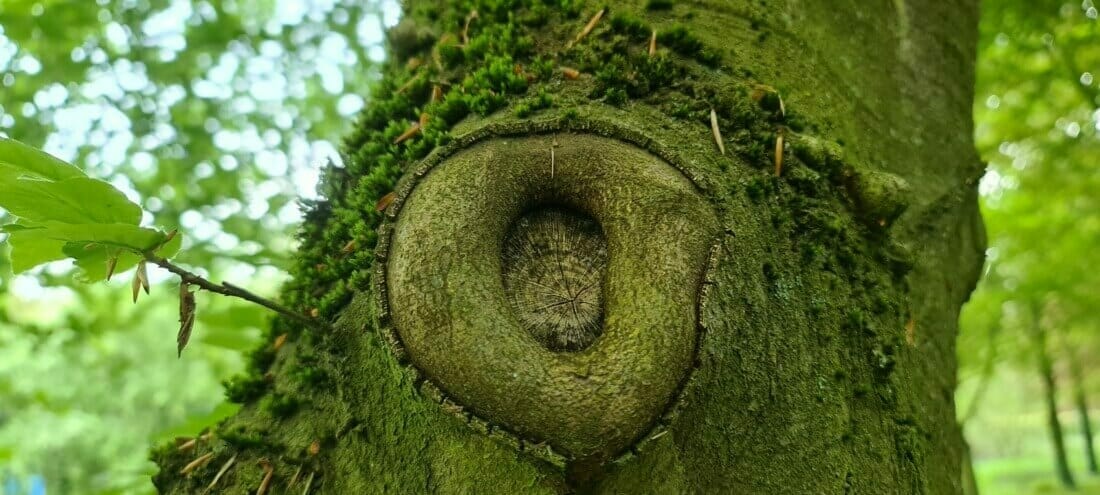

Moment waarop je best een boom gaat snoeien?
Prune at the right time: pruning should be done at the right time of year, depending on the tree species and the pruning purpose. In general, it is preferable for most trees to prune them during the growing season (the late spring and summer months). But some species may benefit from pruning during the winter period, such as repolling trees.
Use proper pruning techniques when pruning a tree
Prune Properly: Pruning should be done in the right place and at the right angle to minimize damage to the tree and promote healing. The pruning standard recommends the following pruning methods:
- Reduction cut: Reduces the size of a branch by pruning it back to a side branch or bud.
- Thinning cut: Removes a branch to its origin or to a side branch to reduce density and improve sunlight penetration deeper into the canopy.
- Fleeting Cut: Prunes a branch back to a stump without leaving a side branch, which can weaken the tree and encourage excessive regrowth.
Pruning with suitable tools: Pruning should be done with suitable tools, such as pruning shears, loppers and pruning saws, that are sharp, clean and well maintained. Using inappropriate tools can damage the tree and increase the risk of injury. A manual pruning saw is often used during climbing pruning.
Despite following best pruning practices, pruning can cause damage to trees if not done carefully. It is therefore best to leave pruning a tree to b-Tree Tree Care. Our Certified Tree Manager has expertise in both crown architecture, species knowledge, tree biology and, above all, a lot of experience behind him.
How to prune trees? How do you go about pruning a tree?
1: Inspect the tree before pruning; determine whether you can prune the tree
Voordat je begint met snoeien, is het belangrijk om de thoroughly inspect the tree and identify any problems. Controleer op beschadigde takken, gebroken of afgeknotte takken, dood hout, scheuren in de stam of takken, of andere tekenen van ziekte of stress. Als je problemen vindt die je niet zelf kunt oplossen, raadpleeg dan een professional tree care provider such as b‑Tree Tree Care.
Even more important is to know what condition your tree is in. Because a tree in poor condition pruning is not allowed. Unless one safety pruning to undergo remove dangerous dead wood. Better get one tree in poor condition a growth site improvement because the tree can then regain its strength.
2: Determine which branches you need to prune and prune away a maximum of 20% of the leaf mass
Bij het bepalen welke takken je gaat snoeien, moet je rekening houden met:
- grootte van de boom,
- vorm van de boom,
- health or condition of the tree,
- locatie van de takken ten opzichte van de totale kroonarchitectuur,
- en omgeving rond de boom.
Make sure that when pruning the crown, light reaches those places where you want more growth from the permanent branches in the future. In this way you control the growth and development of the crown.
For example, by shortening and highlighting branches in the middle section of the crown, you ensure that more light reaches the inner crown. And more light falls on the lower branches of the crown. This ensures that the lower branches are less likely to droop, because they tend to grow upwards rather than because there is now more light there than at the bottom. This means you will have to prune again less quickly.
The crown is slightly more compact in the middle section to ensure that more light reaches the lower branches. This will cause the tree to invest more in the inner crown and be less likely to let its lower branches droop. What was the reason for the pruning here; because the tree is next to the walkway to the front door.
When you start pruning the tree, keep in mind that you will ultimately remove no more than 20% of the total leaf mass. Otherwise the tree may weaken too much. And then it can become infected. And you want to prevent that.
In general, it is better to prune smaller branches rather than large branches. Because small pruning wounds heal better and close faster.
3: Choose the right type of pruning
Er zijn verschillende soorten snoei die je kunt gebruiken, afhankelijk van het eindbeeld dat je wenst te bereiken en van de grootte en locatie van de takken. Enkele veelgebruikte soorten zijn:
Safety pruning
Removal of dead wood, broken branches and branches that overlap or abrasive branches. Note that not all abrasive branches need to be removed. You can often keep these that will grow together and are not about to break. They later form a natural crown anchor and strengthen the crown, just like you would static crown anchorage.
Lift out the crown
Removing branches in the canopy to give the tree a more open structure and appearance. To improve light penetration deeper into the crown and thus stimulate growth within the crown. As a result, the crown becomes fuller again and the tree will invest in growth low in the crown, instead of at the top.
Crown up for a branch-free trunk
Removing branches from the bottom of the crown to increase the height of the tree's branch-free trunk. This will allow better traffic to pass under the tree.
Taking the crown:
Removing and shortening branches, especially on the outside of the crown, to reduce the size of the tree.
Crown reduction
You remove larger parts of the crown to relieve overload on frame branches, such as a breakdown beam (frame branch that has split along part of its length). You then remove more and thicker branches than when taking in the crown.
Read more about the different types of tree pruning.
4: Prune branches properly
It is important to prune the branches correctly to prevent damage to the tree. Here are some practical tips:
Make a clean cut, close to the trunk or other branch, viz right next to the branch collar.
Prune branches not too close to the trunk. Prune here too, right next to the branch collar, because otherwise this can lead to poor healing and rotting.
Pruning is done next to the branch collar for the best healing. In accordance with the European pruning standard.
Avoid pruning large branches that are more than 5 cm thick. Large pruning wounds overgrow with callus too slowly. This increases the risk of infection and damages the health of the tree.
Use a sharp pruning saw to make clean pruning wounds. These will heal faster. A frayed or unclean pruning wound dries out the cambium. And because the cambium is the active growth layer of the branch from which wound overgrowth starts, it should not dry out or at least as little as possible.
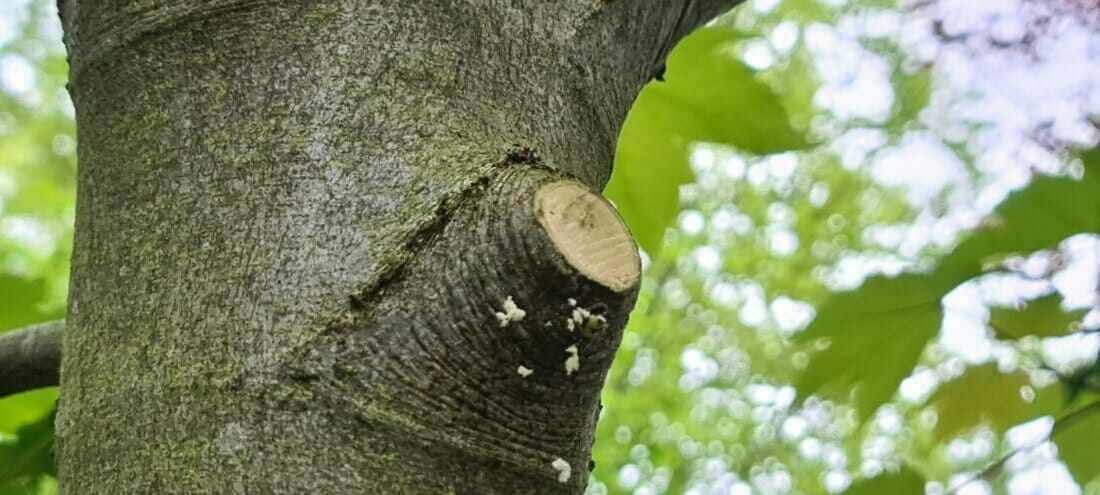
5: Clean up the work environment and chop or dispose of pruning waste
Make sure the area is left tidy. Tidy up all branches and prunings. Chop it if necessary and spread it in a thin layer under the tree. This is suddenly a small growth area improvement. Or you can dispose of the pruning waste or chopped wood.
Working area during the pruning work of the weeping willow.
Final image of the tree and the working environment after pruning and clean-up. Previously, the branches reached the apartment building, but the tree has retained its shape.
Contact us today with your question.
More about the European Tree Pruning Standards (ETPS).
Guideline for professional arborists
The European Tree Pruning Standards (ETPS) are guidelines drawn up to: professional arborists assist in carrying out pruning work on trees. The standard was developed by a group of experts in the field tree care. And aims to ensure consistency and quality in tree pruning throughout Europe.
The ETPS contains specific guidelines and principles to follow when pruning trees. These include maintaining the health and safety of the tree. Also respecting the natural shape and growth patterns of the tree. And reducing the risk of damage to the tree and surroundings.
Emphasis on tree inspection for tree pruning
The standard emphasizes the importance of a thorough inspection and assessment of the tree before carrying out any pruning work. Arborists must take various factors into account. Such as the life stage of the tree, the presence of diseases or pests, the stability of the tree and any nearby structures. Because the arborist takes these factors into account, he will prune the tree with more insight. Which is better for the tree.
Guidelines for the different types of tree pruning
The ETPS also provides guidelines for the different techniques and methods you can use when pruning trees. Such as rejuvenation pruning, it lifting out the crown and the removing dead wood. It is emphasized that pruning work must be carried out by well-trained and experienced arborists. And using suitable tools and techniques.
By following the ETPS, arborists can ensure that they carry out pruning work in a professional and responsible manner. With respect for the health and vitality of the trees. The goal is to promote the aesthetics, safety and sustainability of trees. And to emphasize the value and importance of tree care throughout Europe.
Communication between tree care providers and customers
In addition, the European Tree Pruning Standards also emphasize the importance of communication between arborists and customers. It is essential that the customer's expectations and objectives are clearly understood. So that the pruning work can be adjusted accordingly. Therefore, arborists should also provide advice and information to the client regarding the health and maintenance of the tree.
European pruning standard takes local legislation and customs into account
The ETPS further emphasizes that you must carry out pruning work in accordance with national and local laws and regulations regarding tree care. And with regard to the preservation of green spaces. Environmental considerations, such as preserving biodiversity and reducing negative impacts on the environment, have also been taken into account.
Promote consistency in tree pruning
Compliance with the European Tree Pruning Standards contributes to professional tree care at European level. In summary, consistent and quality pruning promotes the health, safety and beauty of trees. In short, by following this standard, tree care providers have a common basis for their work. They also contribute to the promotion of sustainable green management throughout Europe.
It is important to note that the European Tree Pruning Standards are guidelines and not a legally binding standard. It is up to individual countries and organizations to decide whether they want to adopt and implement this standard.
